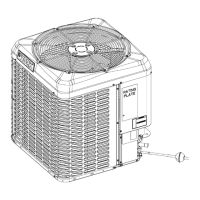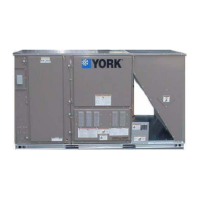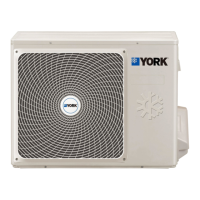2. On a single-piece air handler, take a second
reading in the supply air duct outside of the unit.
On a gas furnace, take the second reading after
the heat exchanger but before the indoor coil.
3. Add the negative return static to the positive
supply static to determine the system total static
pressure. Treat the negative return static as a
positive pressure (even though it is a negative
reading).
4. If there is static pressure on the blower return
(-0.1), add it to a supply static (0.4) which equals a
(0.5) total system static pressure.
5. Compare this value to the table for the indoor
unit's static pressure against CFM or to a curve
chart.
Charging the system
About this task:
NOTICE
For cold weather charging of the system at
temperatures of 55°F or below, see the Optional cold
weather charging procedures near the end of this
section.
CAUTION
R-410A refrigerant cylinders are rose-colored. Always
charge the system slowly with liquid R-410 refrigerant.
The factory charge in the outdoor unit includes enough
charge for the unit, 15 ft (4.6 m) pf interconnecting
refrigerant piping, and the smallest indoor coil match-up.
Some indoor coil matches may require additional charge.
Refer to the Tabular Data Sheet for charge requirements.
CAUTION
Do not leave the system open to the atmosphere.
The total system charge must be permanently stamped
on the unit dataplate. Complete the following steps to
determine the total system charge:
1. Determine the base charge shipped in the outdoor
unit by referring to the Tabular Data Sheet included
with the outdoor unit. (item 1)
2. Determine the charge adder for the matched
indoor unit by referring to the Tabular Data Sheet.
(item 2)
3. If the refrigerant piping is longer than 15 ft (4.6 m),
calculate the charge adder for actual piping length
by referring to the Tabular Data Sheet. (item 3)
4. When the charge adders for the matched indoor
unit and for the refrigerant piping have been
weighed in, verify the system operation against the
temperatures and pressures in the charging chart
for the outdoor unit. Refer to the charging charts
on the outdoor unit or in the Service Application
Data on www.simplygettingthejobdone.com.
Follow the subcool or the superheat charging
procedure in this section according to the type of
indoor metering device in the system and allow
10 min after each charge adjustment for the
system operation to stabilize. Record the charge
adjustment made to match the charging chart.
(item 4)
5. Verify that the total system charge = (item 1) +
(item 2) + (item 3) = (item 4).
6. Permanently stamp the unit data plate with
the total system charge as defined in these
instructions.
Use this method whenever additional refrigerant is
required for the system charge.
WARNING
Do not attempt to pump the total system
charge into the outdoor unit for maintenance
or service. This may cause damage to the
compressor or other components. Recover and
weigh the system charge into an appropriate
recovery cylinder for any instances requiring
evacuation.
WARNING
Do not attempt to pump more than the factory
charge and an additional 15 ft line charge into
a tube and fin outdoor unit for maintenance
or service. This can cause damage to the
compressor or other components.
R-410A Outdoor Split-System Air Conditioning14
Johnson Controls Ducted Systems

